Nanotechnology
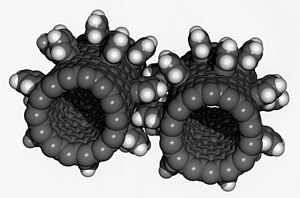
| Part of a series of articles on |
| Nanotechnology |
|---|
| Impact and applications |
| Nanomaterials |
| Molecular self-assembly |
| Nanoelectronics |
| Nanometrology |
| Molecular nanotechnology |
Nanotechnology is the manipulation of matter with at least one dimension sized from 1 to 100 nanometers (nm). At this scale, commonly known as the nanoscale, surface area and quantum mechanical effects become important in describing properties of matter. This definition of nanotechnology includes all types of research and technologies that deal with these special properties. It is common to see the plural form "nanotechnologies" as well as "nanoscale technologies" to refer to research and applications whose common trait is scale.[1] An earlier understanding of nanotechnology referred to the particular technological goal of precisely manipulating atoms and molecules for fabricating macroscale products, now referred to as molecular nanotechnology.[2]
Nanotechnology defined by scale includes fields of science such as surface science, organic chemistry, molecular biology, semiconductor physics, energy storage,[3][4] engineering,[5] microfabrication,[6] and molecular engineering.[7] The associated research and applications range from extensions of conventional device physics to molecular self-assembly,[8] from developing new materials with dimensions on the nanoscale to direct control of matter on the atomic scale.
Nanotechnology may be able to create new materials and devices with diverse applications, such as in nanomedicine, nanoelectronics, biomaterials energy production, and consumer products. However, nanotechnology raises issues, including concerns about the toxicity and environmental impact of nanomaterials,[9] and their potential effects on global economics, as well as various doomsday scenarios. These concerns have led to a debate among advocacy groups and governments on whether special regulation of nanotechnology is warranted.
Origins
The concepts that seeded nanotechnology were first discussed in 1959 by physicist Richard Feynman in his talk There's Plenty of Room at the Bottom, in which he described the possibility of synthesis via direct manipulation of atoms.

The term "nano-technology" was first used by Norio Taniguchi in 1974, though it was not widely known. Inspired by Feynman's concepts, K. Eric Drexler used the term "nanotechnology" in his 1986 book Engines of Creation: The Coming Era of Nanotechnology, which proposed the idea of a nanoscale "assembler" that would be able to build a copy of itself and of other items of arbitrary complexity with atom-level control. Also in 1986, Drexler co-founded The Foresight Institute to increase public awareness and understanding of nanotechnology concepts and implications.
The emergence of nanotechnology as a field in the 1980s occurred through the convergence of Drexler's theoretical and public work, which developed and popularized a conceptual framework, and high-visibility experimental advances that drew additional attention to the prospects. In the 1980s, two breakthroughs sparked the growth of nanotechnology. First, the invention of the scanning tunneling microscope in 1981 enabled visualization of individual atoms and bonds, and was successfully used to manipulate individual atoms in 1989. The microscope's developers Gerd Binnig and Heinrich Rohrer at IBM Zurich Research Laboratory received a Nobel Prize in Physics in 1986.[10][11] Binnig, Quate and Gerber also invented the analogous atomic force microscope that year.
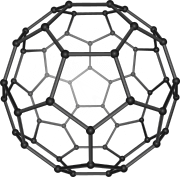
Second, fullerenes (buckyballs) were discovered in 1985 by Harry Kroto, Richard Smalley, and Robert Curl, who together won the 1996 Nobel Prize in Chemistry.[12][13] C60 was not initially described as nanotechnology; the term was used regarding subsequent work with related carbon nanotubes (sometimes called graphene tubes or Bucky tubes) which suggested potential applications for nanoscale electronics and devices. The discovery of carbon nanotubes is largely attributed to Sumio Iijima of NEC in 1991,[14] for which Iijima won the inaugural 2008 Kavli Prize in Nanoscience.
In the early 2000s, the field garnered increased scientific, political, and commercial attention that led to both controversy and progress. Controversies emerged regarding the definitions and potential implications of nanotechnologies, exemplified by the Royal Society's report on nanotechnology.[15] Challenges were raised regarding the feasibility of applications envisioned by advocates of molecular nanotechnology, which culminated in a public debate between Drexler and Smalley in 2001 and 2003.[16]
Meanwhile, commercial products based on advancements in nanoscale technologies began emerging. These products were limited to bulk applications of nanomaterials and did not involve atomic control of matter. Some examples include the Silver Nano platform for using silver nanoparticles as an antibacterial agent, nanoparticle-based sunscreens, carbon fiber strengthening using silica nanoparticles, and carbon nanotubes for stain-resistant textiles.[17][18]
Governments moved to promote and fund research into nanotechnology, such as American the National Nanotechnology Initiative, which formalized a size-based definition of nanotechnology and established research funding, and in Europe via the European Framework Programmes for Research and Technological Development.
By the mid-2000s scientific attention began to flourish. Nanotechnology roadmaps centered on atomically precise manipulation of matter and discussed existing and projected capabilities, goals, and applications.[19][20]
Fundamental concepts
Nanotechnology is the science and engineering of functional systems at the molecular scale. In its original sense, nanotechnology refers to the projected ability to construct items from the bottom up making complete, high-performance products.
One nanometer (nm) is one billionth, or 10−9, of a meter. By comparison, typical carbon–carbon bond lengths, or the spacing between these atoms in a molecule, are in the range 0.12–0.15 nm, and DNA's diameter is around 2 nm. On the other hand, the smallest cellular life forms, the bacteria of the genus Mycoplasma, are around 200 nm in length. By convention, nanotechnology is taken as the scale range 1 to 100 nm, following the definition used by the American National Nanotechnology Initiative. The lower limit is set by the size of atoms (hydrogen has the smallest atoms, which have an approximately ,25 nm kinetic diameter). The upper limit is more or less arbitrary, but is around the size below which phenomena not observed in larger structures start to become apparent and can be made use of.[21] These phenomena make nanotechnology distinct from devices that are merely miniaturized versions of an equivalent macroscopic device; such devices are on a larger scale and come under the description of microtechnology.[22]
To put that scale in another context, the comparative size of a nanometer to a meter is the same as that of a marble to the size of the earth.[23]
Two main approaches are used in nanotechnology. In the "bottom-up" approach, materials and devices are built from molecular components which assemble themselves chemically by principles of molecular recognition.[24] In the "top-down" approach, nano-objects are constructed from larger entities without atomic-level control.[25]
Areas of physics such as nanoelectronics, nanomechanics, nanophotonics and nanoionics have evolved to provide nanotechnology's scientific foundation.
Larger to smaller: a materials perspective

Several phenomena become pronounced as system size. These include statistical mechanical effects, as well as quantum mechanical effects, for example, the "quantum size effect" in which the electronic properties of solids alter along with reductions in particle size. Such effects do not apply at macro or micro dimensions. However, quantum effects can become significant when nanometer scales. Additionally, physical (mechanical, electrical, optical, etc.) properties change versus macroscopic systems. One example is the increase in surface area to volume ratio altering mechanical, thermal, and catalytic properties of materials. Diffusion and reactions can be different as well. Systems with fast ion transport are referred to as nanoionics. The mechanical properties of nanosystems are of interest in research.
Simple to complex: a molecular perspective
Modern synthetic chemistry can prepare small molecules of almost any structure. These methods are used to manufacture a wide variety of useful chemicals such as pharmaceuticals or commercial polymers. This ability raises the question of extending this kind of control to the next-larger level, seeking methods to assemble single molecules into supramolecular assemblies consisting of many molecules arranged in a well-defined manner.
These approaches utilize the concepts of molecular self-assembly and/or supramolecular chemistry to automatically arrange themselves into a useful conformation through a bottom-up approach. The concept of molecular recognition is important: molecules can be designed so that a specific configuration or arrangement is favored due to non-covalent intermolecular forces. The Watson–Crick basepairing rules are a direct result of this, as is the specificity of an enzyme targeting a single substrate, or the specific folding of a protein. Thus, components can be designed to be complementary and mutually attractive so that they make a more complex and useful whole.
Such bottom-up approaches should be capable of producing devices in parallel and be much cheaper than top-down methods, but could potentially be overwhelmed as the size and complexity of the desired assembly increases. Most useful structures require complex and thermodynamically unlikely arrangements of atoms. Nevertheless, many examples of self-assembly based on molecular recognition in exist in biology, most notably Watson–Crick basepairing and enzyme-substrate interactions.
Molecular nanotechnology: a long-term view
Molecular nanotechnology, sometimes called molecular manufacturing, concerns engineered nanosystems (nanoscale machines) operating on the molecular scale. Molecular nanotechnology is especially associated with molecular assemblers, machines that can produce a desired structure or device atom-by-atom using the principles of mechanosynthesis. Manufacturing in the context of productive nanosystems is not related to conventional technologies used to manufacture nanomaterials such as carbon nanotubes and nanoparticles.
When Drexler independently coined and popularized the term "nanotechnology", he envisioned manufacturing technology based on molecular machine systems. The premise was that molecular-scale biological analogies of traditional machine components demonstrated molecular machines were possible: biology was full of examples of sophisticated, stochastically optimized biological machines.
Drexler and other researchers[26] have proposed that advanced nanotechnology ultimately could be based on mechanical engineering principles, namely, a manufacturing technology based on the mechanical functionality of these components (such as gears, bearings, motors, and structural members) that would enable programmable, positional assembly to atomic specification.[27] The physics and engineering performance of exemplar designs were analyzed in Drexler's book Nanosystems: Molecular Machinery, Manufacturing, and Computation.[2]
In general, assembling devices on the atomic scale requires positioning atoms on other atoms of comparable size and stickiness. Carlo Montemagno's view is that future nanosystems will be hybrids of silicon technology and biological molecular machines.[28] Richard Smalley argued that mechanosynthesis was impossible due to difficulties in mechanically manipulating individual molecules.[citation needed]
This led to an exchange of letters in the ACS publication Chemical & Engineering News in 2003.[29] Though biology clearly demonstrates that molecular machines are possible, non-biological molecular machines remained in their infancy. Alex Zettl and colleagues at Lawrence Berkeley Laboratories and UC Berkeley[30] constructed at least three molecular devices whose motion is controlled via changing voltage: a nanotube nanomotor, a molecular actuator,[31] and a nanoelectromechanical relaxation oscillator.[32]
Ho and Lee at Cornell University in 1999 used a scanning tunneling microscope to move an individual carbon monoxide molecule (CO) to an individual iron atom (Fe) sitting on a flat silver crystal and chemically bound the CO to the Fe by applying a voltage.[citation needed]
Research
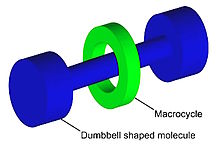
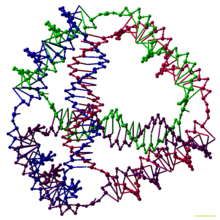
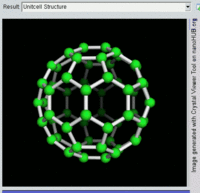
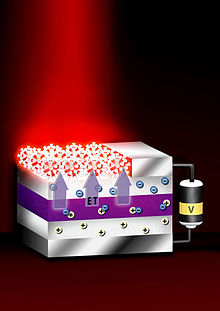
Nanomaterials
Many areas of science develop or study materials having unique properties arising from their nanoscale dimensions.[35]
- Interface and colloid science produced many materials that may be useful in nanotechnology, such as carbon nanotubes and other fullerenes, and various nanoparticles and nanorods. Nanomaterials with fast ion transport are related to nanoionics and nanoelectronics.
- Nanoscale materials can be used for bulk applications; most commercial applications of nanotechnology are of this flavor.
- Progress has been made in using these materials for medical applications, including tissue engineering, drug delivery, antibacterials and biosensors.[36][37][38][39][40]
- Nanoscale materials such as nanopillars are used in solar cells.
- Applications incorporating semiconductor nanoparticles in products such as display technology, lighting, solar cells and biological imaging; see quantum dots.
Bottom-up approaches
The bottom-up approach seeks to arrange smaller components into more complex assemblies.
- DNA nanotechnology utilizes Watson–Crick basepairing to construct well-defined structures out of DNA and other nucleic acids.
- Approaches from the field of "classical" chemical synthesis (Inorganic and organic synthesis) aim at designing molecules with well-defined shape (e.g. bis-peptides[41]).
- More generally, molecular self-assembly seeks to use concepts of supramolecular chemistry, and molecular recognition in particular, to cause single-molecule components to automatically arrange themselves into some useful conformation.
- Atomic force microscope tips can be used as a nanoscale "write head" to deposit a chemical upon a surface in a desired pattern in a process called dip pen nanolithography. This technique fits into the larger subfield of nanolithography.
- Molecular Beam Epitaxy allows for bottom-up assemblies of materials, most notably semiconductor materials commonly used in chip and computing applications, stacks, gating, and nanowire lasers.
Top-down approaches
These seek to create smaller devices by using larger ones to direct their assembly.
- Many technologies that descended from conventional solid-state silicon methods for fabricating microprocessors are capable of creating features smaller than 100 nm. Giant magnetoresistance-based hard drives already on the market fit this description,[42] as do atomic layer deposition (ALD) techniques. Peter Grünberg and Albert Fert received the Nobel Prize in Physics in 2007 for their discovery of giant magnetoresistance and contributions to the field of spintronics.[43]
- Solid-state techniques can be used to create nanoelectromechanical systems or NEMS, which are related to microelectromechanical systems or MEMS.
- Focused ion beams can directly remove material, or even deposit material when suitable precursor gasses are applied at the same time. For example, this technique is used routinely to create sub-100 nm sections of material for analysis in Transmission electron microscopy.
- Atomic force microscope tips can be used as a nanoscale "write head" to deposit a resist, which is then followed by an etching process to remove material in a top-down method.
Functional approaches
Functional approaches seek to develop useful components without regard to how they might be assembled.
- Magnetic assembly for the synthesis of anisotropic superparamagnetic materials such as magnetic nano chains.[24]
- Molecular scale electronics seeks to develop molecules with useful electronic properties. These could be used as single-molecule components in a nanoelectronic device,[44] such as rotaxane.
- Synthetic chemical methods can be used to create synthetic molecular motors, such as in a so-called nanocar.
Biomimetic approaches
- Bionics or biomimicry seeks to apply biological methods and systems found in nature to the study and design of engineering systems and modern technology. Biomineralization is one example of the systems studied.
- Bionanotechnology is the use of biomolecules for applications in nanotechnology, including the use of viruses and lipid assemblies.[45][46] Nanocellulose, a nanopolymer often used for bulk-scale applications, has gained interest owing to its useful properties such as abundance, high aspect ratio, good mechanical properties, renewability, and biocompatibility.[47]
Speculative
These subfields seek to anticipate what inventions nanotechnology might yield, or attempt to propose an agenda along which inquiry could progress. These often take a big-picture view, with more emphasis on societal implications than engineering details.
- Molecular nanotechnology is a proposed approach that involves manipulating single molecules in finely controlled, deterministic ways. This is more theoretical than the other subfields, and many of its proposed techniques are beyond current capabilities.
- Nanorobotics considers self-sufficient machines operating at the nanoscale. There are hopes for applying nanorobots in medicine.[48][49] Nevertheless, progress on innovative materials and patented methodologies have been demonstrated.[50][51]
- Productive nanosystems are "systems of nanosystems" could produce atomically precise parts for other nanosystems, not necessarily using novel nanoscale-emergent properties, but well-understood fundamentals of manufacturing. Because of the discrete (i.e. atomic) nature of matter and the possibility of exponential growth, this stage could form the basis of another industrial revolution. Mihail Roco proposed four states of nanotechnology that seem to parallel the technical progress of the Industrial Revolution, progressing from passive nanostructures to active nanodevices to complex nanomachines and ultimately to productive nanosystems.[52]
- Programmable matter seeks to design materials whose properties can be easily, reversibly and externally controlled though a fusion of information science and materials science.
- Due to the popularity and media exposure of the term nanotechnology, the words picotechnology and femtotechnology have been coined in analogy to it, although these are used only informally.
Dimensionality in nanomaterials
Nanomaterials can be classified in 0D, 1D, 2D and 3D nanomaterials. Dimensionality plays a major role in determining the characteristic of nanomaterials including physical, chemical, and biological characteristics. With the decrease in dimensionality, an increase in surface-to-volume ratio is observed. This indicates that smaller dimensional nanomaterials have higher surface area compared to 3D nanomaterials. Two dimensional (2D) nanomaterials have been extensively investigated for electronic, biomedical, drug delivery and biosensor applications.
Tools and techniques

Scanning microscopes
The atomic force microscope (AFM) and the Scanning Tunneling Microscope (STM) are two versions of scanning probes that are used for nano-scale observation. Other types of scanning probe microscopy have much higher resolution, since they are not limited by the wavelengths of sound or light.
The tip of a scanning probe can also be used to manipulate nanostructures (positional assembly). Feature-oriented scanning may be a promising way to implement these nano-scale manipulations via an automatic algorithm.[53][54] However, this is still a slow process because of low velocity of the microscope.
The top-down approach anticipates nanodevices that must be built piece by piece in stages, much as manufactured items are made. Scanning probe microscopy is an important technique both for characterization and synthesis. Atomic force microscopes and scanning tunneling microscopes can be used to look at surfaces and to move atoms around. By designing different tips for these microscopes, they can be used for carving out structures on surfaces and to help guide self-assembling structures. By using, for example, feature-oriented scanning approach, atoms or molecules can be moved around on a surface with scanning probe microscopy techniques.[53][54]
Lithography
Various techniques of lithography, such as optical lithography, X-ray lithography, dip pen lithography, electron beam lithography or nanoimprint lithography offer top-down fabrication techniques where a bulk material is reduced to a nano-scale pattern.
Another group of nano-technological techniques include those used for fabrication of nanotubes and nanowires, those used in semiconductor fabrication such as deep ultraviolet lithography, electron beam lithography, focused ion beam machining, nanoimprint lithography, atomic layer deposition, and molecular vapor deposition, and further including molecular self-assembly techniques such as those employing di-block copolymers.[55]
Bottom-up
In contrast, bottom-up techniques build or grow larger structures atom by atom or molecule by molecule. These techniques include chemical synthesis, self-assembly and positional assembly. Dual-polarization interferometry is one tool suitable for characterization of self-assembled thin films. Another variation of the bottom-up approach is molecular-beam epitaxy or MBE. Researchers at Bell Telephone Laboratories including John R. Arthur. Alfred Y. Cho, and Art C. Gossard developed and implemented MBE as a research tool in the late 1960s and 1970s. Samples made by MBE were key to the discovery of the fractional quantum Hall effect for which the 1998 Nobel Prize in Physics was awarded. MBE lays down atomically precise layers of atoms and, in the process, build up complex structures. Important for research on semiconductors, MBE is also widely used to make samples and devices for the newly emerging field of spintronics.
Therapeutic products based on responsive nanomaterials, such as the highly deformable, stress-sensitive Transfersome vesicles, are approved for human use in some countries.[56]
Applications
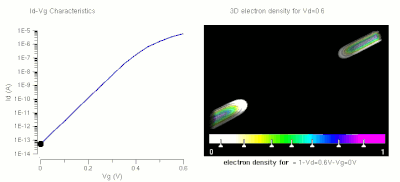
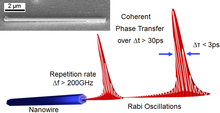
This section needs to be updated. (May 2024) |
As of August 21, 2008, the Project on Emerging Nanotechnologies estimated that over 800 manufacturer-identified nanotech products were publicly available, with new ones hitting the market at a pace of 3–4 per week.[18] Most applications are "first generation" passive nanomaterials that includes titanium dioxide in sunscreen, cosmetics, surface coatings,[57] and some food products; Carbon allotropes used to produce gecko tape; silver in food packaging, clothing, disinfectants, and household appliances; zinc oxide in sunscreens and cosmetics, surface coatings, paints and outdoor furniture varnishes; and cerium oxide as a fuel catalyst.[17]
In the electric car industry, single wall carbon nanotubes (SWCNTs) address key lithium-ion battery challenges, including energy density, charge rate, service life, and cost. SWCNTs connect electrode particles during charge/discharge process, preventing battery premature degradation. Their exceptional ability to wrap active material particles enhanced electrical conductivity and physical properties, setting them apart multi-walled carbon nanotubes and carbon black.[58][59][60]
Further applications allow tennis balls to last longer, golf balls to fly straighter, and bowling balls to become more durable. Trousers and socks have been infused with nanotechnology to last longer and lower temperature in the summer. Bandages are infused with silver nanoparticles to heal cuts faster.[61] Video game consoles and personal computers may become cheaper, faster, and contain more memory thanks to nanotechnology.[62] Also, to build structures for on chip computing with light, for example on chip optical quantum information processing, and picosecond transmission of information.[63]
Nanotechnology may have the ability to make existing medical applications cheaper and easier to use in places like the doctors' offices and at homes.[64] Cars use nanomaterials in such ways that car parts require fewer metals during manufacturing and less fuel to operate in the future.[65]
Nanoencapsulation involves the enclosure of active substances within carriers. Typically, these carriers offer advantages, such as enhanced bioavailability, controlled release, targeted delivery, and protection of the encapsulated substances. In the medical field, nanoencapsulation plays a significant role in drug delivery. It facilitates more efficient drug administration, reduces side effects, and increases treatment effectiveness. Nanoencapsulation is particularly useful for improving the bioavailability of poorly water-soluble drugs, enabling controlled and sustained drug release, and supporting the development of targeted therapies. These features collectively contribute to advancements in medical treatments and patient care.[66][67]
Nanotechnology may play role in tissue engineering. When designing scaffolds, researchers attempt to mimic the nanoscale features of a cell's microenvironment to direct its differentiation down a suitable lineage.[68] For example, when creating scaffolds to support bone growth, researchers may mimic osteoclast resorption pits.[69]
Researchers used DNA origami-based nanobots capable of carrying out logic functions to target drug delivery in cockroaches.[70]
A nano bible (a .5mm2 silicon chip) was created by the Technion in order to increase youth interest in nanotechnology.[71]
Implications
One concern is the effect that industrial-scale manufacturing and use of nanomaterials will have on human health and the environment, as suggested by nanotoxicology research. For these reasons, some groups advocate that nanotechnology be regulated. However, regulation might stifle scientific research and the development of beneficial innovations. Public health research agencies, such as the National Institute for Occupational Safety and Health research potential health effects stemming from exposures to nanoparticles.[72][73]
Nanoparticle products may have unintended consequences. Researchers have discovered that bacteriostatic silver nanoparticles used in socks to reduce foot odor are released in the wash.[74] These particles are then flushed into the wastewater stream and may destroy bacteria that are critical components of natural ecosystems, farms, and waste treatment processes.[75]
Public deliberations on risk perception in the US and UK carried out by the Center for Nanotechnology in Society found that participants were more positive about nanotechnologies for energy applications than for health applications, with health applications raising moral and ethical dilemmas such as cost and availability.[76]
Experts, including director of the Woodrow Wilson Center's Project on Emerging Nanotechnologies David Rejeski, testified[77] that commercialization depends on adequate oversight, risk research strategy, and public engagement. As of 206 Berkeley, California was the only US city to regulate nanotechnology.[78]
Health and environmental concerns
Inhaling airborne nanoparticles and nanofibers may contribute to pulmonary diseases, e.g. fibrosis.[79] Researchers found that when rats breathed in nanoparticles, the particles settled in the brain and lungs, which led to significant increases in biomarkers for inflammation and stress response[80] and that nanoparticles induce skin aging through oxidative stress in hairless mice.[81][82]
A two-year study at UCLA's School of Public Health found lab mice consuming nano-titanium dioxide showed DNA and chromosome damage to a degree "linked to all the big killers of man, namely cancer, heart disease, neurological disease and aging".[83]
A Nature Nanotechnology study suggested that some forms of carbon nanotubes could be as harmful as asbestos if inhaled in sufficient quantities. Anthony Seaton of the Institute of Occupational Medicine in Edinburgh, Scotland, who contributed to the article on carbon nanotubes said "We know that some of them probably have the potential to cause mesothelioma. So those sorts of materials need to be handled very carefully."[84] In the absence of specific regulation forthcoming from governments, Paull and Lyons (2008) have called for an exclusion of engineered nanoparticles in food.[85] A newspaper article reports that workers in a paint factory developed serious lung disease and nanoparticles were found in their lungs.[86][87][88][89]
Regulation
Calls for tighter regulation of nanotechnology have accompanied a debate related to human health and safety risks.[90] Some regulatory agencies cover some nanotechnology products and processes – by "bolting on" nanotechnology to existing regulations – leaving clear gaps.[91] Davies proposed a road map describing steps to deal with these shortcomings.[92]
Andrew Maynard, chief science advisor to the Woodrow Wilson Center's Project on Emerging Nanotechnologies, reported insufficient funding for human health and safety research, and as a result inadequate understanding of human health and safety risks.[93] Some academics called for stricter application of the precautionary principle, slowing marketing approval, enhanced labelling and additional safety data.[94]
A Royal Society report identified a risk of nanoparticles or nanotubes being released during disposal, destruction and recycling, and recommended that "manufacturers of products that fall under extended producer responsibility regimes such as end-of-life regulations publish procedures outlining how these materials will be managed to minimize possible human and environmental exposure".[15]
See also
- Carbon nanotube
- Electrostatic deflection (molecular physics/nanotechnology)
- Energy applications of nanotechnology
- Ethics of nanotechnologies
- Ion implantation-induced nanoparticle formation
- Gold nanoparticle
- List of emerging technologies
- List of nanotechnology organizations
- List of software for nanostructures modeling
- Magnetic nanochains
- Materiomics
- Nano-thermite
- Molecular design software
- Molecular mechanics
- Nanobiotechnology
- Nanoelectromechanical relay
- Nanoengineering
- Nanofluidics
- NanoHUB
- Nanometrology
- Nanoneuronics
- Nanoparticle
- Nanoscale networks
- Nanotechnology education
- Nanotechnology in fiction
- Nanotechnology in water treatment
- Nanoweapons
- National Nanotechnology Initiative
- Self-assembly of nanoparticles
- Top-down and bottom-up
- Translational research
- Wet nanotechnology
References
- ^ Drexler KE (1986). Engines of Creation: The Coming Era of Nanotechnology. Doubleday. ISBN 978-0-385-19973-5. OCLC 12752328.
- ^ a b Drexler KE (1992). Nanosystems: Molecular Machinery, Manufacturing, and Computation. Wiley. ISBN 978-0-471-57547-4. OCLC 26503231.
- ^ Hubler A (2010). "Digital quantum batteries: Energy and information storage in nanovacuum tube arrays". Complexity. 15 (5): 48–55. doi:10.1002/cplx.20306. ISSN 1076-2787. S2CID 6994736.
- ^ Shinn E (2012). "Nuclear energy conversion with stacks of graphene nanocapacitors". Complexity. 18 (3): 24–27. Bibcode:2013Cmplx..18c..24S. doi:10.1002/cplx.21427. S2CID 35742708.
- ^ Elishakoff I, Dujat K, Muscolino G, Bucas S, Natsuki T, Wang CM, et al. (March 2013). Carbon Nanotubes and Nano Sensors: Vibrations, Buckling, and Ballistic Impact. John Wiley & Sons. ISBN 978-1-84821-345-6.
- ^ Lyon D, Hubler A (2013). "Gap size dependence of the dielectric strength in nano vacuum gaps". IEEE Transactions on Dielectrics and Electrical Insulation. 20 (4): 1467–71. doi:10.1109/TDEI.2013.6571470. S2CID 709782.
- ^ Saini R, Saini S, Sharma S (January 2010). "Nanotechnology: the future medicine". Journal of Cutaneous and Aesthetic Surgery. 3 (1): 32–33. doi:10.4103/0974-2077.63301. PMC 2890134. PMID 20606992.
- ^ Belkin A, Hubler A, Bezryadin A (February 2015). "Self-assembled wiggling nano-structures and the principle of maximum entropy production". Scientific Reports. 5: 8323. Bibcode:2015NatSR...5.8323B. doi:10.1038/srep08323. PMC 4321171. PMID 25662746.
- ^ Buzea C, Pacheco II, Robbie K (December 2007). "Nanomaterials and nanoparticles: sources and toxicity". Biointerphases. 2 (4): MR17–MR71. arXiv:0801.3280. doi:10.1116/1.2815690. PMID 20419892. S2CID 35457219.
- ^ Binnig G, Rohrer H (1986). "Scanning tunneling microscopy". IBM Journal of Research and Development. 30 (4): 355–369. doi:10.1147/rd.441.0279.
- ^ "Press Release: the 1986 Nobel Prize in Physics". Nobelprize.org. 15 October 1986. Archived from the original on 5 June 2011. Retrieved 12 May 2011.
- ^ Kroto HW, Heath JR, O'Brien SC, Curl RF, Smalley RE (1985). "C60: Buckminsterfullerene". Nature. 318 (6042): 162–3. Bibcode:1985Natur.318..162K. doi:10.1038/318162a0. S2CID 4314237.
- ^ Adams WW, Baughman RH (December 2005). "Retrospective: Richard E. Smalley (1943-2005)". Science. 310 (5756): 1916. doi:10.1126/science.1122120. PMID 16373566.
- ^ Monthioux M, Kuznetsov V (2006). "Who should be given the credit for the discovery of carbon nanotubes?" (PDF). Carbon. 44 (9): 1621–3. Bibcode:2006Carbo..44.1621M. doi:10.1016/j.carbon.2006.03.019. Archived from the original (PDF) on 2009-09-29. Retrieved 2019-07-09.
- ^ a b "Nanoscience and nanotechnologies: opportunities and uncertainties". Royal Society and Royal Academy of Engineering. July 2004. p. xiii. Archived from the original on 26 May 2011. Retrieved 13 May 2011.
- ^ "Nanotechnology: Drexler and Smalley make the case for and against 'molecular assemblers'". Chemical & Engineering News. 81 (48): 37–42. 1 December 2003. doi:10.1021/cen-v081n036.p037. Retrieved 9 May 2010.
- ^ a b "Nanotechnology Information Center: Properties, Applications, Research, and Safety Guidelines". American Elements. Archived from the original on 26 December 2014. Retrieved 13 May 2011.
- ^ a b "Analysis: This is the first publicly available on-line inventory of nanotechnology-based consumer products". The Project on Emerging Nanotechnologies. 2008. Archived from the original on 5 May 2011. Retrieved 13 May 2011.
- ^ "Productive Nanosystems Technology Roadmap" (PDF). Archived (PDF) from the original on 2013-09-08.
- ^ "NASA Draft Nanotechnology Roadmap" (PDF). Archived (PDF) from the original on 2013-01-22.
- ^ Allhoff F, Lin P, Moore D (2010). What is nanotechnology and why does it matter?: from science to ethics. Wiley. pp. 3–5. ISBN 978-1-4051-7545-6. OCLC 830161740.
- ^ Prasad SK (2008). Modern Concepts in Nanotechnology. Discovery Publishing House. pp. 31–32. ISBN 978-81-8356-296-6. OCLC 277278905.
- ^ Kahn J (2006). "Nanotechnology". National Geographic. 2006 (June): 98–119.
- ^ a b Kralj S, Makovec D (October 2015). "Magnetic Assembly of Superparamagnetic Iron Oxide Nanoparticle Clusters into Nanochains and Nanobundles". ACS Nano. 9 (10): 9700–7. doi:10.1021/acsnano.5b02328. PMID 26394039.
- ^ Rodgers P (2006). "Nanoelectronics: Single file". Nature Nanotechnology. doi:10.1038/nnano.2006.5.
- ^ Phoenix C (March 2005). "Nanotechnology: Developing Molecular Manufacturing". Archived from the original on 2020-06-01.. crnano.org
- ^ "Some papers by K. Eric Drexler". imm.org. Archived from the original on 2006-04-11.
- ^ "Carlo Montemagno, Ph.D." California NanoSystems Institute (CNSI), University of California, Los Angeles (UCLA). Archived from the original on 2014-10-08.
- ^ Baum R (December 1, 2003). "Cover Story – Nanotechnology". Chemical and Engineering News. 81 (48): 37–42.
- ^ "Zettl Research Group". Department of Physics, University of California, Berkeley. Archived from the original on 2015-10-08.
- ^ Regan BC, Aloni S, Jensen K, Ritchie RO, Zettl A (September 2005). "Nanocrystal-powered nanomotor" (PDF). Nano Letters. 5 (9): 1730–3. Bibcode:2005NanoL...5.1730R. doi:10.1021/nl0510659. OSTI 1017464. PMID 16159214. Archived from the original (PDF) on 2006-05-10.
- ^ Regan BC, Aloni S, Jensen K, Zettl A (2005). "Surface-tension-driven nanoelectromechanical relaxation oscillator" (PDF). Applied Physics Letters. 86 (12): 123119. Bibcode:2005ApPhL..86l3119R. doi:10.1063/1.1887827. Archived (PDF) from the original on 2006-05-26.
- ^ Goodman RP, Schaap IA, Tardin CF, Erben CM, Berry RM, Schmidt CF, et al. (December 2005). "Rapid chiral assembly of rigid DNA building blocks for molecular nanofabrication". Science. 310 (5754): 1661–5. Bibcode:2005Sci...310.1661G. doi:10.1126/science.1120367. PMID 16339440. S2CID 13678773.
- ^ "Wireless Nanocrystals Efficiently Radiate Visible Light". Photonics Online. 12 July 2004. Archived from the original on 14 November 2012. Retrieved 5 August 2015.
- ^ Narayan RJ, Kumta PN, Sfeir C, Lee DH, Choi D, Olton D (2004). "Nanostructured Ceramics in Medical Devices: Applications and Prospects". JOM. 56 (10): 38–43. Bibcode:2004JOM....56j..38N. doi:10.1007/s11837-004-0289-x. S2CID 137324362.
- ^ Cho H, Pinkhassik E, David V, Stuart JM, Hasty KA (May 2015). "Detection of early cartilage damage using targeted nanosomes in a post-traumatic osteoarthritis mouse model". Nanomedicine. 11 (4): 939–946. doi:10.1016/j.nano.2015.01.011. PMID 25680539.
- ^ Kerativitayanan P, Carrow JK, Gaharwar AK (August 2015). "Nanomaterials for Engineering Stem Cell Responses". Advanced Healthcare Materials. 4 (11): 1600–27. doi:10.1002/adhm.201500272. PMID 26010739. S2CID 21582516.
- ^ Gaharwar A, Sant S, Hancock M, Hacking S, eds. (2013). Nanomaterials in tissue engineering : fabrication and applications. Oxford: Woodhead Publishing. doi:10.1533/9780857097231. ISBN 978-0-85709-596-1.
- ^ Gaharwar AK, Peppas NA, Khademhosseini A (March 2014). "Nanocomposite hydrogels for biomedical applications". Biotechnology and Bioengineering. 111 (3): 441–453. doi:10.1002/bit.25160. PMC 3924876. PMID 24264728.
- ^ Eslamian L, Borzabadi-Farahani A, Karimi S, Saadat S, Badiee MR (July 2020). "Evaluation of the Shear Bond Strength and Antibacterial Activity of Orthodontic Adhesive Containing Silver Nanoparticle, an In-Vitro Study". Nanomaterials. 10 (8): 1466. doi:10.3390/nano10081466. PMC 7466539. PMID 32727028.
- ^ Levins CG, Schafmeister CE (2006). "The Synthesis of Curved and Linear Structures from a Minimal Set of Monomers". ChemInform. 37 (5). doi:10.1002/chin.200605222.
- ^ "Applications/Products". National Nanotechnology Initiative. Archived from the original on 2010-11-20. Retrieved 2007-10-19.
- ^ "The Nobel Prize in Physics 2007". Nobelprize.org. Archived from the original on 2011-08-05. Retrieved 2007-10-19.
- ^ Das S, Gates AJ, Abdu HA, Rose GS, Picconatto CA, Ellenbogen JC (2007). "Designs for Ultra-Tiny, Special-Purpose Nanoelectronic Circuits". IEEE Transactions on Circuits and Systems I. 54 (11): 2528–40. doi:10.1109/TCSI.2007.907864. S2CID 13575385.
- ^ Mashaghi S, Jadidi T, Koenderink G, Mashaghi A (February 2013). "Lipid nanotechnology". International Journal of Molecular Sciences. 14 (2): 4242–82. doi:10.3390/ijms14024242. PMC 3588097. PMID 23429269.
- ^ Hogan CM (May 2010). Draggan S (ed.). "Virus". Encyclopedia of Earth, National Council for Science and the Environment. Archived from the original on 2013-05-13.
- ^ Trache D, Tarchoun AF, Derradji M, Hamidon TS, Masruchin N, Brosse N, et al. (2020). "Nanocellulose: From Fundamentals to Advanced Applications". Frontiers in Chemistry. 8: 392. Bibcode:2020FrCh....8..392T. doi:10.3389/fchem.2020.00392. PMC 7218176. PMID 32435633.
- ^ Kubik T, Bogunia-Kubik K, Sugisaka M (February 2005). "Nanotechnology on duty in medical applications". Current Pharmaceutical Biotechnology. 6 (1): 17–33. doi:10.2174/1389201053167248. PMID 15727553.
- ^ Leary SP, Liu CY, Apuzzo ML (June 2006). "Toward the emergence of nanoneurosurgery: part III--nanomedicine: targeted nanotherapy, nanosurgery, and progress toward the realization of nanoneurosurgery". Neurosurgery. 58 (6): 1009–26. doi:10.1227/01.NEU.0000217016.79256.16. PMID 16723880. S2CID 33235348.
- ^ Cavalcanti A, Shirinzadeh B, Freitas RA, Kretly LC (2007). "Medical nanorobot architecture based on nanobioelectronics". Recent Patents on Nanotechnology. 1 (1): 1–10. doi:10.2174/187221007779814745. PMID 19076015. S2CID 9807497.
- ^ Boukallel M, Gauthier M, Dauge M, Piat E, Abadie J (August 2007). "Smart microrobots for mechanical cell characterization and cell convoying" (PDF). IEEE Transactions on Bio-Medical Engineering. 54 (8): 1536–40. doi:10.1109/TBME.2007.891171. PMID 17694877. S2CID 1119820.
- ^ Roco MC (December 2005). "International Perspective on Government Nanotechnology Funding in 2005" (PDF). Journal of Nanoparticle Research. 7: 707–712. doi:10.1007/s11051-005-3141-5. Archived from the original (PDF) on 2012-01-31.
- ^ a b Lapshin RV (2004). "Feature-oriented scanning methodology for probe microscopy and nanotechnology" (PDF). Nanotechnology. 15 (9): 1135–51. Bibcode:2004Nanot..15.1135L. doi:10.1088/0957-4484/15/9/006. S2CID 250913438. Archived from the original on 2013-09-09.
- ^ a b Lapshin RV (2011). "Feature-oriented scanning probe microscopy". In Nalwa HS (ed.). Encyclopedia of Nanoscience and Nanotechnology (PDF). Vol. 14. American Scientific. pp. 105–115. ISBN 978-1-58883-163-7. Archived from the original on 2013-09-09.
- ^ Kafshgari MH, Voelcker NH, Harding FJ (2015). "Applications of zero-valent silicon nanostructures in biomedicine". Nanomedicine. 10 (16): 2553–71. doi:10.2217/nnm.15.91. PMID 26295171.
- ^ Rajan R, Jose S, Mukund VP, Vasudevan DT (July 2011). "Transferosomes - A vesicular transdermal delivery system for enhanced drug permeation". Journal of Advanced Pharmaceutical Technology & Research. 2 (3): 138–143. doi:10.4103/2231-4040.85524. PMC 3217704. PMID 22171309.
- ^ Kurtoglu ME, Longenbach T, Reddington P, Gogotsi Y (2011). "Effect of Calcination Temperature and Environment on Photocatalytic and Mechanical Properties of Ultrathin Sol–Gel Titanium Dioxide Films". Journal of the American Ceramic Society. 94 (4): 1101–8. doi:10.1111/j.1551-2916.2010.04218.x.
- ^ Guo M, Cao Z, Liu Y, Ni Y, Chen X, Terrones M, et al. (May 2023). "Preparation of Tough, Binder-Free, and Self-Supporting LiFePO4 Cathode by Using Mono-Dispersed Ultra-Long Single-Walled Carbon Nanotubes for High-Rate Performance Li-Ion Battery". Advanced Science. 10 (13): e2207355. doi:10.1002/advs.202207355. PMC 10161069. PMID 36905241.
- ^ Jimenez NP, Balogh MP, Halalay IC (April 2021). "High Porosity Single-Phase Silicon Negative Electrode Made with Phase-Inversion". Journal of the Electrochemical Society. 168 (4): 040507. doi:10.1149/1945-7111/abe3f1. ISSN 0013-4651.
- ^ "Single wall CNT cells: high energy density anodes & cathodes". tuball.com. OCSiAl. Retrieved 2024-07-02.
- ^ "Nanotechnology Consumer Products". National Nanotechnology Infrastructure Network. 2010. Archived from the original on January 19, 2012. Retrieved November 23, 2011.
- ^ "Nano in computing and electronics". NanoandMe.org. Archived from the original on 2011-11-14.
- ^ Mayer B, Janker L, Loitsch B, Treu J, Kostenbader T, Lichtmannecker S, et al. (January 2016). "Monolithically Integrated High-β Nanowire Lasers on Silicon". Nano Letters. 16 (1): 152–156. Bibcode:2016NanoL..16..152M. doi:10.1021/acs.nanolett.5b03404. PMID 26618638.
- ^ "Nano in medicine". NanoandMe.org. Archived from the original on 2011-11-14.
- ^ "Nano in transport". NanoandMe.org. Archived from the original on 2011-10-29.
- ^ Kumari A, Singla R, Guliani A, Yadav SK (March 2014). "Nanoencapsulation for drug delivery". EXCLI Journal. 13: 265–286. PMC 4464443. PMID 26417260.
- ^ Suganya V, Anuradha V (March 2017). "Microencapsulation and Nanoencapsulation: A Review". ResearchGate. Retrieved 28 October 2023.
- ^ Cassidy JW (November 2014). "Nanotechnology in the Regeneration of Complex Tissues". Bone and Tissue Regeneration Insights. 5: 25–35. doi:10.4137/BTRI.S12331. PMC 4471123. PMID 26097381.
- ^ Cassidy JW, Roberts JN, Smith CA, Robertson M, White K, Biggs MJ, et al. (February 2014). "Osteogenic lineage restriction by osteoprogenitors cultured on nanometric grooved surfaces: the role of focal adhesion maturation". Acta Biomaterialia. 10 (2): 651–660. doi:10.1016/j.actbio.2013.11.008. PMC 3907683. PMID 24252447. Archived from the original on 2017-08-30.
- ^ Amir Y, Ben-Ishay E, Levner D, Ittah S, Abu-Horowitz A, Bachelet I (May 2014). "Universal computing by DNA origami robots in a living animal". Nature Nanotechnology. 9 (5): 353–357. Bibcode:2014NatNa...9..353A. doi:10.1038/nnano.2014.58. PMC 4012984. PMID 24705510.
- ^ "Technion Nano Bible, world's smallest, displayed at Smithsonian". The Jerusalem Post | JPost.com. 2015-11-04. Retrieved 2024-06-25.
- ^ "Nanotechnology". NIOSH Workplace Safety and Health Topic. National Institute for Occupational Safety and Health. June 15, 2012. Archived from the original on September 4, 2015. Retrieved 2012-08-24.
- ^ "Filling the Knowledge Gaps for Safe Nanotechnology in the Workplace". NIOSH Publications and Products. National Institute for Occupational Safety and Health. November 7, 2012. doi:10.26616/NIOSHPUB2013101. 2013-101. Archived from the original on November 11, 2012. Retrieved 2012-11-08.
- ^ Lubick N (June 2008). "Silver socks have cloudy lining". Environmental Science & Technology. 42 (11): 3910. Bibcode:2008EnST...42.3910L. doi:10.1021/es0871199. PMID 18589943. S2CID 26887347.
- ^ Murray RG (1993). "A Perspective on S-Layer Research". In Beveridge TJ, Koval SF (eds.). Advances in Bacterial Paracrystalline Surface Layers. Plenum Press. pp. 3–9. doi:10.1007/978-1-4757-9032-0_1. ISBN 978-0-306-44582-8.
- ^ Harthorn BH (2009-01-23). "People in the US and the UK show strong similarities in their attitudes toward nanotechnologies". Nanotechnology Today. Archived from the original on 2011-08-23.
- ^ "Testimony of David Rejeski for U.S. Senate Committee on Commerce, Science and Transportation". Project on Emerging Nanotechnologies. Archived from the original on 2008-04-08. Retrieved 2008-03-07.
- ^ DelVecchio R (2006-11-24). "Berkeley considering need for nano safety". SFGate. Archived from the original on 2010-09-02.
- ^ Byrne JD, Baugh JA (January 2008). "The significance of nanoparticles in particle-induced pulmonary fibrosis". McGill Journal of Medicine. 11 (1): 43–50. PMC 2322933. PMID 18523535.
- ^ Elder A (2006-08-03). "Tiny Inhaled Particles Take Easy Route from Nose to Brain". University of Rochester Medical Center. Archived from the original on 2015-01-23.
- ^ Wu J, Liu W, Xue C, Zhou S, Lan F, Bi L, et al. (December 2009). "Toxicity and penetration of TiO2 nanoparticles in hairless mice and porcine skin after subchronic dermal exposure". Toxicology Letters. 191 (1): 1–8. doi:10.1016/j.toxlet.2009.05.020. PMID 19501137.
- ^ Jonaitis TS, Card JW, Magnuson B (February 2010). "Concerns regarding nano-sized titanium dioxide dermal penetration and toxicity study". Toxicology Letters. 192 (2): 268–269. doi:10.1016/j.toxlet.2009.10.007. PMID 19836437.
- ^ Schneider A (2010-03-24). "Amid Nanotech's Dazzling Promise, Health Risks Grow". AOL News. Archived from the original on 2010-03-26.
- ^ Weiss R (2008). "Effects of Nanotubes May Lead to Cancer, Study Says". The Washington Post. Archived from the original on 2011-06-29.
- ^ Paull J, Lyons K (2008). "Nanotechnology: The Next Challenge for Organics" (PDF). Journal of Organic Systems. 3: 3–22. Archived (PDF) from the original on 2011-07-18.
- ^ Smith R (August 19, 2009). "Nanoparticles used in paint could kill, research suggests". Telegraph. London. Archived from the original on March 15, 2010. Retrieved May 19, 2010.
- ^ "Nanofibres 'may pose health risk'". BBC News. 2012-08-24. Archived from the original on 2012-08-25.
- ^ Schinwald A, Murphy FA, Prina-Mello A, Poland CA, Byrne F, Movia D, et al. (August 2012). "The threshold length for fiber-induced acute pleural inflammation: shedding light on the early events in asbestos-induced mesothelioma". Toxicological Sciences. 128 (2): 461–470. doi:10.1093/toxsci/kfs171. PMID 22584686.
- ^ Stix G (July 2007). "Is Chronic Inflammation the Key to Unlocking the Mysteries of Cancer?". Scientific American.
- ^ Rollins K. "Nanobiotechnology Regulation: A Proposal for Self-Regulation with Limited Oversight". Nanotechnology Law Business. 6 (2). Nems Mems Works, LLC. Archived from the original on 14 July 2011. Retrieved 2 September 2010.
- ^ Bowman D, Hodge G (2006). "Nanotechnology: Mapping the Wild Regulatory Frontier". Futures. 38 (9): 1060–73. doi:10.1016/j.futures.2006.02.017.
- ^ Davies JC (2008). "Nanotechnology Oversight: An Agenda for the Next Administration". Archived from the original on 2008-11-20..
- ^ Maynard A (2008-04-16). "Testimony by Dr. Andrew Maynard for the U.S. House Committee on Science and Technology". Archived from the original on 2010-12-05. Retrieved 2008-11-24.
- ^ Faunce T, Murray K, Nasu H, Bowman D (2008). "Sunscreen Safety: The Precautionary Principle, the Australian Therapeutic Goods Administration and Nanoparticles in Sunscreens". NanoEthics. 2 (3): 231–240. doi:10.1007/s11569-008-0041-z. S2CID 55719697.
External links
- What is Nanotechnology? (A Vega/BBC/OU Video Discussion).

